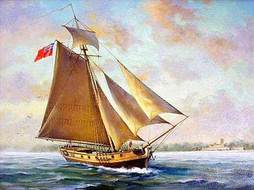British and Colonial History in St. Augustine

BRITISH SHIP CALLED INDUSTRY WHICH RAN AROUND IN ST. AUGUSTINE IN 1764 (SOME HISTORIANS INFER IT WAS AN EARLY CASE OF INSURANCE FRAUD)
The British never conquered St. Augustine, even after a 28 day siege and burning the town.
Only through international diplomacy did the British get to rule St. Augustine from 1763 to 1783, winning it (and losing it) by two treaties among European powers, each called the "Treaty of Paris."
The British sought to establish a plantation economy and during the British period the majority of St. Augustine residents were African-American. During the British period, slave merchants plied their trade, for the first time directly importing slaves from Africa. One of the slave traders was Richard Oswald, who established plantations south of St. Augustine and bragged that the area was a "paradise" and a "new Canaan." As slave trade historian Hugh Thomas writes, it was "a Canaan from which no milk and honey would flow for years, for the land produced almost nothing."
In 1776, when the Declaration of Independence was signed, the British Loyalists in St. Augustine burned the Declaration of Independence and burned in effigy John Adams and John Hancock. Three signers of the Declaration of Independence were held prisoners by the British here and were allowed to wander around the small garrison town as involuntary guests of Mad King George III and his Loyalists.
In 1777, under British rule, St. Augustine got its first newspaper. There had never been a printing press or newspaper here before then. The news which St. Augustinians read came in newspapers on packet boats from South Carolina or Georgia.
The British left St. Augustine shortly after the Americans defeated them at Yorktown, Virginia. The Second Treaty of Paris returned Florida (and St. Augustine) from Britain to Spain. Representing the British was none other than slave trader Richard Oswald, negotiating with an American delegation led by Philadelphia's Ben Franklin (Oswald's former partner in land speculation) and Herny Laurens of South Carolina (a former slave trader who had purchased Oswald's slaves).
Left behind was Jesse Fish, who allegedly profited from departing British colonials by selling their real estate back to the Spanish and pocketing the proceeds. Jesse Fish is buried on Fish Island, where he ran his plantation. The land adjoins the beautiful marshes southeast of the State Road 312 Bridge.
Jesse Fish is buried in lands that developers unsuccessfully sought to turn into condominiums and a boat dock bigger than an aircraft carrier. These lands would be protected under the St. Augustine National Historical Park and Seashore.